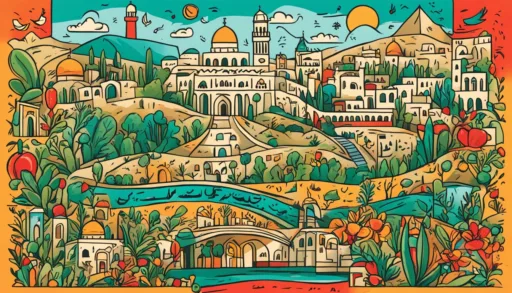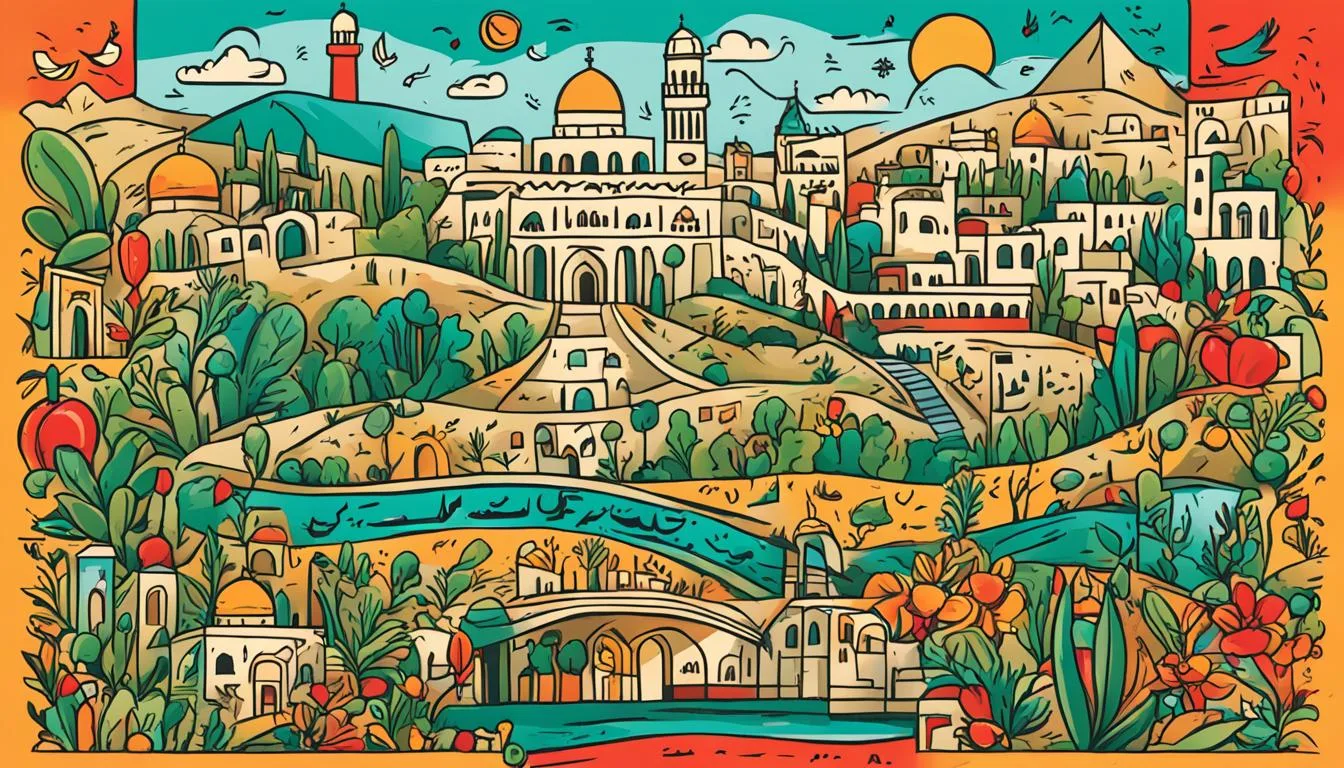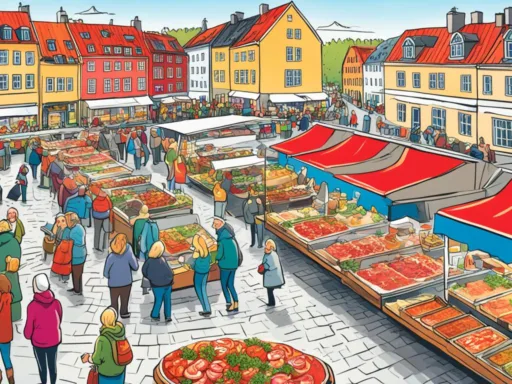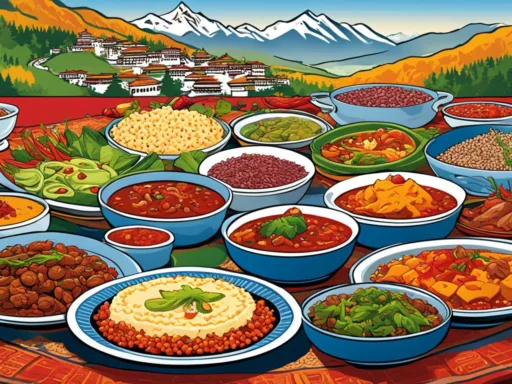With over 1.8 million words spoken daily in a multitude of dialects and languages, the State of Palestine presents a striking example of linguistic diversity. To many, the mosaic of languages spoken in the State of Palestine is an emblem of the region’s complex cultural and historical fabric. This aural landscape stretches beyond a single tongue, spanning a range of idioms from the Levantine cadences of Palestinian Arabic to the ancient echoes of Hebrew, and the varied rhythmic patterns brought by waves of migration. Retracing the lines on this linguistic map reveals a story rich with influence and adaptation—a chronicle where language is both witness and narrator.
The very essence of linguistic diversity in Palestine is encapsulated not just in its official proceedings but in the marketplace banter, the colloquial chatter of friends, and the solemn verses of traditional poetry. This interweaving of voices forms a tapestry of intangible heritage, colored with the vocabularies of history, solidarity, and identity. The linguistic portrait of Palestine, thus, is not simply a matter of statistics—it’s a living, breathing testament to resilience and unity through words.
Key Takeaways
- State of Palestine’s linguistic landscape reflects a compelling blend of tradition and plurality.
- Palestinian Arabic, as the cornerstone, is enlivened with dialectical variations that transcend national borders.
- Hebrew’s presence in Palestine has gained prominence in correlation with the sociopolitical changes of the last century.
- Russian and Amharic are emergent threads in the Palestinian linguistic tapestry, introduced by waves of Jewish migrants.
- The use of European languages, especially French, underscores the cross-cultural exchanges enriching Palestine’s heritage.
- Palestine’s everyday polyglot reality is an evolution driven by its diverse population and their interactions.
The Rich Linguistic Tapestry of Palestine
The State of Palestine is a symphony of languages, dynamic and vibrant, telling tales of its people’s history and the socio-political intricacies that shape the region. At the heart of this symphony is the Arabic language, resonating with the distinct nuances of the Palestinian dialect. This local version of Arabic has not only remained central to the Palestinian identity but has also travelled across borders, touching the lives of Arab citizens of Israel and those in the Palestinian diaspora.
Understanding the linguistic diversity in Palestine invites us into a world where language is imbricated with cultural and historical influences that have shaped the nation’s narrative. The Arabic languages in the State of Palestine serve as a living relic, chronicling centuries of change, conflict, and coalescence.
The language profile in Palestine is as diverse as it is fascinating, reflecting a mosaic of communities that bring together a plethora of languages, each adding a distinct thread to the region’s linguistic fabric. Here, words connect, adapt, and evolve, painting a vivid portrait of Palestinian heritage and the enduring spirit of its people.
- Palestinian Arabic, a linguistic cornerstone
- The echoing voices of Arab citizens of Israel
- A global link: The Palestinian diaspora
- Historical layers: Various cultures and languages interwoven
In essence, the linguistic diversity in Palestine is a testament to the resilience and adaptability of its people, navigating an ever-evolving socio-political landscape while maintaining the essence of their language as a unifying identity marker. It is this rich tapestry that echoes the true spirit of Palestine — diverse, enduring, and profoundly human.
Official and Primary Language: Palestinian Arabic
As the cradle of ancient civilizations, the State of Palestine is home to a linguistic heritage that is both profound and enduring. Among the many tongues spoken, Palestinian Arabic stands as the official language, anchoring the cultural and social identity of its people. This Levantine Arabic dialect, intimately affiliated with the Palestinian nation, is the predominant mode of expression from the urban centers of the West Bank to the diverse refugee communities scattered across the globe.
The Unique Dialects of Palestinian Arabic
Palestinian dialects, which are melodious and rich with historical narratives, vary notably from one region to another. The Palestinian Arabic spoken in Gaza mirrors the city’s vibrant trading history with Egypt, while in the mountains of the West Bank, the dialect retains archaic forms that hark back to a bygone era. These regional nuances extend to internationally dispersed Palestinians, where the diaspora continues to foster these dialects, weaving them into the fabric of a shared and evolving identity.
Phonology and Pronunciation of Palestinian Arabic
The acoustic features of Palestinian dialects are a testament to the language’s evolution, having absorbed influences from a myriad of sources like Aramaic, Hebrew, Turkish, and English. The distinct pronunciation patterns of words are not merely linguistic curiosities but are a reflection of the Palestinian people’s historical journey. As official languages in Palestine intersect within local vernaculars, they create a rich phonological tapestry that is unique to the region and its inhabitants.

Hebrew in Palestine: History and Current Use
The historical narrative of Hebrew in Palestine is rich and multifaceted, reflecting the region’s complex past and the ebb and flow of sociopolitical influences. Initially, Hebrew functioned more as a liturgical language within Jewish communities. However, from the early 20th century, the Zionist movement began to revitalize Hebrew, leading to its establishment as a vernacular in regions where Jewish populations were present.
The linguistic diversity in Palestine today can be partially attributed to the Hebrew language’s revival, which has become increasingly commonplace, especially within the Israeli settlements of the West Bank. This change introduced a dual-language reality for many Palestinians, where understanding and occasionally speaking Hebrew became part of everyday life.

Contemporary usage of Hebrew among Palestinians often arises in the marketplace, in the realms of employment and education, and through media consumption. This practical bilingualism is a testament to the adaptability of the Palestinian people and illustrates a distinct facet of official languages in Palestine. Despite the politically charged atmosphere, Hebrew has indeed cemented its role in Palestinian society, offering a glimpse into the intertwined histories of these lands.
Hebrew, once primarily a language of scripture and religious study, now mingles with Arabic in the streets of Jerusalem and the West Bank.
For Palestinians living in proximity to or within Israeli-controlled areas, proficiency in Hebrew can be seen as an economic asset, if not a necessity. This linguistic cross-pollination, while a marker of conflict and cohabitation, paradoxically serves as a bridge for understanding, exemplifying the region’s linguistic diversity. Even as politics continually shape the language dynamics in Palestine, the living tapestry of language continues to evolve, weaving together threads of historical legacy and present-day pragmatism.
The Influence of Migration: Russian and Amharic Languages
The linguistic diversity in Palestine has been significantly shaped by waves of migration, bringing with them a variety of languages that contribute to the already complex linguistic landscape. Particularly noteworthy is the influence of the languages spoken by communities who have made Aliyah, immigrating to the region from Ethiopia and the former Soviet Union, introducing Amharic and Russian to the array of languages spoken in the State of Palestine.

These migratory patterns began to alter the linguistic composition of Palestine, reflecting not only the changing demographics but also the cultural exchanges that have ensued. Russian speakers, comprising a sizeable group due to the historical Aliyah from the Soviet Union, have established communities where the Russian language is actively maintained. Similarly, the migration from Ethiopia has brought Amharic into the Palestinian linguistic fold, with cultural institutions fostering the retention and expression of these migrants’ linguistic heritage.
The integration of these languages demonstrates the ongoing evolution of the linguistic diversity in Palestine. It is a telling example of how history, politics, and people’s movements intricately weave together to form the social fabric of a region. While Amharic and Russian might not be as widely spoken as Arabic or Hebrew in the public sphere, they hold significant importance in the private lives and communities of those who speak them.
- Amharic – Language of Ethiopian migrants, reflecting the historical connection between Ethiopia and Palestine.
- Russian – Spoken by migrants from former Soviet territories, enriching the State’s educational and cultural institutions.
The preservation and celebration of these languages are critical not only for the communities for which they are a lifeline to their culture but also for the overall fabric of Palestinian society, which prides itself on its multicultural and multilingual identity.
European Languages in Palestine: Legacy of Migration
The historical ebb and flow of people groups have significantly shaped the linguistic landscape of the State of Palestine. Among the various tongues that have carved a niche in the region, European languages hold a mirror to the past and present human migrations. French, in particular, commands a unique position within this context – a window to the enduring cultural interplay between Palestine and Europe.
French: A Lingua Franca in Palestine
Within the State of Palestine, the French language continues to flourish as a result of longstanding ties and ongoing exchanges in education and diplomacy. Notably used by a cross-section of Palestinian society, the French language in State of Palestine serves as a lingua franca, opening doors to international relations and opportunities for cultural exchange.
Other European Languages Brought by Migrants
The fabric of Palestinian society is woven with strands of various European languages in Palestine, each thread representing communities with roots stretching back to European soils. The languages introduced by Jewish migrants enrich the cultural tapestry, adding layers of linguistic diversity to the region.
| European Language | Presence in Palestine | Impact on Society |
|---|---|---|
| French | Used in education, diplomacy, and international trade | Cultural exchanges and educational opportunities |
| Italian | Present among certain migrant communities and through Italian institutions in Palestine | Contributes to the gastronomy and heritage conservation sectors |
| Spanish | Emerging within educational programs and cultural initiatives | Promotes linguistic diversity and opens avenues for global connectivity |
| German | Found in historical and religious tourism, NGO work | Steady influence in academic scholarships and tech collaborations |
| Russian | Widely used among the existing Russian-speaking communities | Enriches the multicultural urban centers of Palestine |
As waves of migration have influenced the region, the European languages in Palestine are a testament to its evolving character. They capture not just words and grammar, but the very essence of the State’s ever-changing identity.
Languages Spoken State of Palestine
The languages spoken in the State of Palestine form a fascinating fabric that reflects the region’s history, cultural interchanges, and sociopolitical dynamics. The official languages in Palestine are a testament to the region’s historical narrative and its ongoing exchanges with the broader global community. Palestinian Arabic stands out as the primary language, not only being a means of communication but also embodying a rich cultural heritage. Hebrew, spoken widely due to historical reasons, continues to be prevalent particularly in areas with close interactions between Palestinians and the Israeli population.
In addition to these primary tongues, the impacts of migration have introduced languages such as Russian and Amharic. This linguistic diversity is compounded by the presence of French, which has been maintained through historical connections and continues to be used in various aspects of Palestinian life. The tableau of European languages brought to the region by migrants presents a vivid picture of a society that has been crafted through various waves of migration, each leaving its own linguistic mark.
- Palestinian Arabic – the vibrant core of social and official discourse
- Hebrew – coexisting in multilingual communities and official matters
- Russian and Amharic – symbols of the diverse influences of migration
- French – a legacy language maintaining its relevance in education and diplomacy
- Other European Languages – reflective of the rich tapestry of Palestine’s population
The interwoven landscape of the languages spoken in the State of Palestine not only provides a snapshot of the region’s multifaceted identity but also enhances the potential for cultural and educational exchange. This linguistic plurality remains a significant component of Palestine’s charm, contributing to its unique position within the Middle East and the world at large.
Language Learning and Preservation in Palestine
The quest for linguistic empowerment and the safeguarding of cultural identity is prominent in the region, with a surge in language learning in Palestine initiatives. Revitalizing and upholding Palestinian Arabic is not merely an educational venture; it stands as a significant emblem of national heritage and identity.
Resources and Tools for Learning Palestinian Arabic
Fostering a connection to the language, a growing repository of Palestinian Arabic resources aids learners and educators alike. These resources are thoughtfully designed to cater to varying proficiency levels and learning styles, ensuring a comprehensive and engaging educational experience.
- Comprehensive online platforms offering structured language courses.
- Dictionaries that provide valuable insight into the richness of Palestinian Arabic lexicon.
- Phonetic guides that assist in pronouncing the distinct sounds of the language with accuracy.
Educational Institutions and Language Preservation
Educational institutions in Palestine are the cornerstone of efforts toward language preservation in Palestine. They provide not only academic instruction but also serve as cultural havens, enhancing the vitality of Palestinian Arabic and other regional languages through scholarly research and community programs.
- Universities offering specialized degrees in Arabic language and literature.
- Cultural organizations hosting events that celebrate linguistic diversity.
- Initiatives that digitize and archive historic texts and spoken tales in Palestinian Arabic.
The harmonious synergy between available learning materials and the academic commitment of educational bodies lays a foundation for language preservation, bridging the gap between past, present, and future speakers of Palestinian Arabic.
Linguistic Diversity in Social and Cultural Contexts
Exploring the vibrant cultural tapestry of Palestine reveals a society steeped in linguistic diversity. In every corner of Palestinian society, multiple languages not only cohabit but are an intrinsic part of the rich fabric that makes up the State of Palestine’s unique character. This expression through language is prominently witnessed in the domains of media and literature, and in the nuanced interactions of everyday life.
Language Use in Palestinian Media and Literature
In Palestinian media spaces, a variety of languages come into play, each serving as a vessel for delivering news, entertainment, and educational content to the diverse audiences within and beyond the nation’s borders. The blend of Palestinian media languages includes Arabic as the foundation, intertwined with English and Hebrew, thus mirroring the intricate political and cultural settings that mark Palestinian life. Space is also given to Russian and French, reflecting the influences of historical migrations on the modern media spectrum.
Turning to the realm of the written word, Palestinian literature languages echo the same multilingual pattern, offering readers a reflection of Palestinian society’s multifaceted voice. The literature is not merely a medium for storytelling but serves as an archive of the cultural and linguistic heritage of the people. Palestinian Arabic, interlaced with its distinctive dialects and idiomatic phrases, sits at the heart of this literary enterprise while being complemented by translations and influences from global languages.
Everyday Communication: Multilingualism in Action
The practice of multilingualism in Palestine reaches beyond formal structures into the vibrant streets and homes where everyday language use in State of Palestine showcases the adaptability of the Palestinian society. Code-switching among Arabic, Hebrew, and English is a common occurrence, not as a mere linguistic phenomenon but as a daily reality that embraces the complexities of coexistence. This dynamic interaction among different languages has become an emblem of identity and resilience for the Palestinian people, functioning as both a bridge and a testament to their rich cultural narrative.
- Arabic for familial and community ties
- Hebrew for business and cross-cultural interactions
- English for international communication and education
- Other languages as remnants of the diaspora’s influence
The mosaic of languages spoken every day is more than mere communication; it is an artefact of history and an instrument for forging interconnected futures. In every conversation, transaction, and broadcast, the people of Palestine participate in a linguistic symphony that resonates with the echoes of their collective stories and aspirations.
Conclusion
The State of Palestine presents a kaleidoscope of tongues that serve as living threads weaving together a cloth of incredible cultural and historical significance. As we have seen, the languages spoken in the State of Palestine are far from monolithic; Palestinian Arabic leads the symphony of dialects, resonating with the essence of regional identity. Yet, it is in the harmonious diversity where one truly senses the depth of the region’s linguistic repertoire. Hebrew, existing alongside Arabic, recounts a story of geographical proximity and sociopolitical resonance, while Russian, Amharic, and a bouquet of European languages, including French, add distinct notes to the linguistic medley.
Embarking on a venture through the State’s bustling streets, one cannot help but be struck by the fundamental role language plays in forming connections, shaping aspirations, and heralding the past’s echoes into the present zeitgeist. In Palestine, the linguistic diversity is not an abstract concept but an everyday reality—an embodiment of resilience, an exchange of knowledge, and a bridge between various facets of society.
As chroniclers of culture, we recognize the power of language in its purest form—the spoken word, the written narrative, the silently understood sign. Here, in the State of Palestine, that power is magnified, prompting us to appreciate the beauty and complexity of its linguistic landscape. Indeed, the linguistic diversity in Palestine is a remarkable edifice of the region’s endurance and steadfastness, standing testament to the enduring vibrancy of its people and their unwavering spirit.






